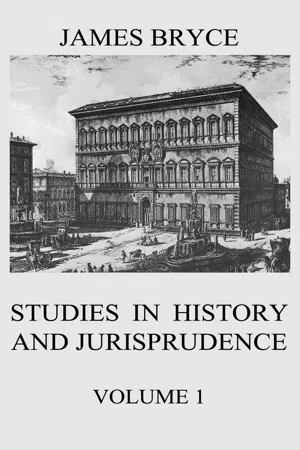Footnotes:
Ref. 002
The total area of the Russian Empire exceeds 8,000,000 square miles, and the population is about 130,000,000.
Ref. 003
Dacia was taken by Trajan in ad 107, and lost in ad 251. Mesopotamia and Arabia Petraea were annexed by Trajan about the same time, but the former was renounced so soon afterwards that its conquest can hardly be considered a part of the regular process of expansion.
Ref. 004
Territorial authority may be said to date from the grant of the Diwani in 1765.
Ref. 005
See the admirably clear and thoughtful book of Sir A. C. Lyall, Rise of British Dominion in India, pp. 52 and 126.
Ref. 006
And indeed the employment of these barbarians to resist the outer barbarians probably prolonged the life of the Empire.
Ref. 007
An incident like the murder in 1889 of the British Resident at Manipur, a small Protected State in the hill country between Assam and Burma, is so rare and excites so much surprise and horror as to be the best proof of the general tranquillity. In that case there had been some provocation, though not on the part of the Resident himself, an excellent man of conciliatory temper.
Ref. 008
Poems x and xxviii. It is some comfort to know that Catullus obtained in Bithynia only themes for some of his most charming verses (see poems iv and xlvi). Gains would probably have been ill-gotten.
Ref. 009
See Sir C. P. Ilbert’s Government of India, p. 68. The provision creating this Court has never been repealed.
Ref. 010
The nearest approach to any kind of provincial self-government and also the nearest approach to a representative system was made in the Provincial Councils which seem from the time of Augustus down to the fifth century to have existed in all or nearly all the provinces. They consisted of delegates from the cities of each province, and met annually in some central place, where stood the temple or altar to Rome and Augustus. They were presided over by the priest of these divinities, and their primary functions were to offer sacrifices, provide for the expense of the annual games, and elect the priest for next year. However they seem to have also passed resolutions, such as votes of thanks to the outgoing priest or to a departing governor, and to have transmitted requests or inquiries to the Emperor. Sometimes they arranged for the prosecution of a governor who had misgoverned them but on the whole their functions were more ceremonial and ornamental than practically important; nor would the emperors have suffered them to exert any real power, though they were valued as useful vehicles of provincial opinion (see Marquardt, Romische Staatsverwaltung, vol. i, and an article in Eng. Hist. Review for April, 1893, by Mr. E. G. Hardy).
Ref. 011
The use of the word to denote the two great ecclesiastical divisions of England (Province of Canterbury and Province of York) is a relic of the Roman imperial system.
Ref. 012
For instance, Cappadocia, Pontus, and Commagene were left as subject kingdoms till 17 ad, 63 ad, and 72 ad respectively.
Ref. 013
‘The extent to which confidence has been restored by Lord Canning’s edict is shown by the curious fact that since its promulgation a childless ruler very rarely adopts in his own lifetime. An heir presumptive, who knows that he is to succeed and who may possibly grow restive if his inheritance is delayed, is for various obscure reasons not the kind of person whom an Oriental ruler cares to see idling about his palace, so that a politic chief oftens prefers leaving the duty of nominating a successor to his widows, who know his mind and have every reason for wishing him long life.’—Sir A. C. Lyall in Law Quarterly Review for October, 1893.
Ref. 014
One finds something similar to this Land-settlement in the Roman plan of determining the land revenue of a province by what was called the lex provinciae.
Ref. 015
Rice, however, is sent from Lower Burma into India proper.
Ref. 016
The total revenue of British India was, in ad 1840, 200,000,000 of rupees, and in 1898-9, 1,014,427,000 rupees, more than a fourth of which was land revenue and less than one-fourth from railways. (The exchange value of the rupee, formerly about two shillings, is now about one shilling and four pence.) £190,000,000 has been expended upon railways in British India and the Native States. The land revenue is somewhat increasing with the bringing of additional land under cultivation. It is estimated that forty-two per cent of the cultivable area is available for further cultivation. The funded debt of India is now £195,000,000, the unfunded about £12,000,000.
Ref. 017
After the fifth century, Armenians, Isaurians, and Northern Macedonians figure more largely in the Eastern Empire than do natives of the provinces round the Aegaean.
Ref. 018
Among these exceptions may be mentioned Sir Syed Ahmed of Aligurh, and the late Mr. Justice Trimbak Telang of Bombay, both men of remarkable force and elevation of character.
Ref. 019
The subahdar, however, is rather a non-commissioned than a commissioned officer, and is not a member of the British officers’ mess.
Ref. 020
Russia places Musulmans from the Caucasian provinces in high military posts. But she has no army corresponding to the native army in India, and as she ha...
